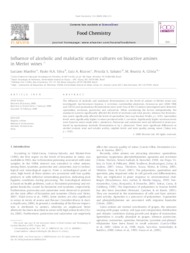Influence of alcoholic and malolactic starter cultures on bioactive amines.
Influence of alcoholic and malolactic starter cultures on bioactive amines.
Author(s): MANFROI, L.; SILVA, P. H. A.; RIZZON, L. A.; SABAINI, P. S.; GLÓRIA, M. B. A
Summary: The influence of alcoholic and malolactic fermentations on the levels of amines in Merlot wines was investigated. Saccharomyces bayanus, S. cerevisiae, Lactobacillus plantarum, Oenococcus oeni (DSM 7008 and 12923) and spontaneous fermentations were used. Four of the 10 amines investigated were detected: spermidine, serotonin, putrescine and cadaverine. When considering the factors independently, the malolactic bacteria significantly affected the levels of serotonin and total amines, whereas the fermentation yeasts significantly affected the levels of spermidine (two way Kruskal?Wallis, p 6 0.05). Spermidine levels were significantly higher in wines produced with S. cerevisiae. Significantly higher serotonin levels were found in wines made with L. plantarum. Putrescine and cadaverine were not detected in wines produced by spontaneous alcoholic fermentation or by L. plantarum. There were significant differences in alcohol content, total and volatile acidity, sulphite levels and taste quality among wines (Tukey test, p 6 0.05).
Publication year: 2009
Types of publication: Journal article
Unit: Embrapa Grape & Wine
Keywords: Amina bioativa, Enologia, Fermentação Alcoólica, Fermentação maloláctica, Merlot, Vinho
Observation
Some of Embrapa's publications are published as ePub files. To read them, use or download one of the following free software options to your computer or mobile device. Android: Google Play Books; IOS: iBooks; Windows and Linux: Calibre.
Access other publications
Access the Agricultural Research Database (BDPA) to consult Embrapa's full library collection and records.
Visit Embrapa Bookstore to purchase books and other publications sold by Embrapa.

